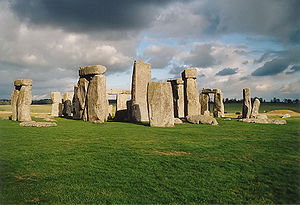
For
Stonehenge fans there's a
fun site over at National Geographic, to go with a documentary that's screening next week called Stonehenge Decoded (20 November, 8pm EST). The film features the work of Mike Parker Pearson of the University of Sheffield and his colleagues, who have been excavating the areas around the site in the
Stonehenge Riverside Project. After finding cremated remains at the site, Parker Pearson thinks that Stonehenge was a place to bury and commemorate
the dead.
The website includes a whole load of video clips, interactive graphics and so on, including one that features archaeologists' discovery of a series of huge holes in the ground by a nearby river, which they think may have held wooden posts that supported platforms on which dead bodies where laid out to decay. There's an interesting blog post here suggesting that cremation would have been costly and time-consuming, so may have been reserved for the elite, with everyone else getting their bones picked clean instead.
There are plenty of other theories for Stonehenge, of course, including an astronomical observatory, a healing centre, and even a landing site for UFOs (why do some people attribute everything they don't understand to either God or aliens?)
One fascinating book published earlier this year looked not at the purpose of Stonehenge, but at how it was designed and built. In Solving Stonehenge, archaeologist Anthony Johnson argued that the site's design is based on repeating formulae that shows that its Bronze Age builders had a sophisticated understanding of geometry and symmetry, including hexagons, pentagons and right angles. In particular he mentions a decorated lozenge shaped sheet of gold, discovered at a nearby Bronze Age burial mound called Bush Barrow. He thinks the decoration of parallel straight lines and zigzags was transferred to landscape designs at sites like Stonehenge.